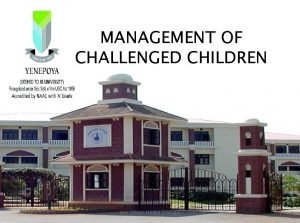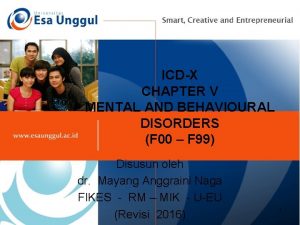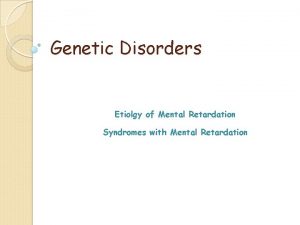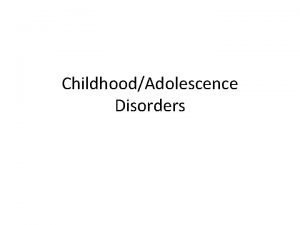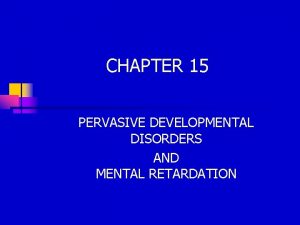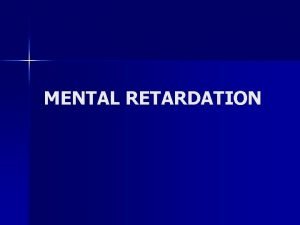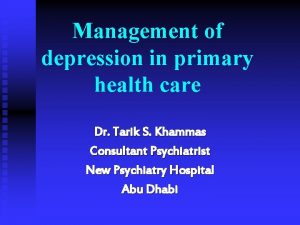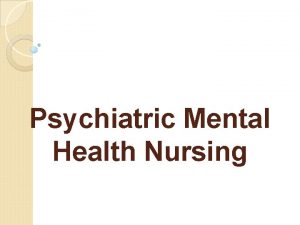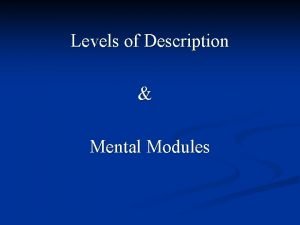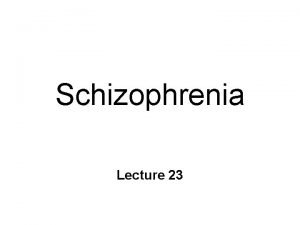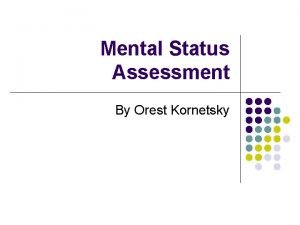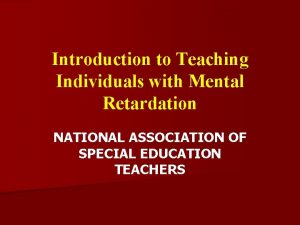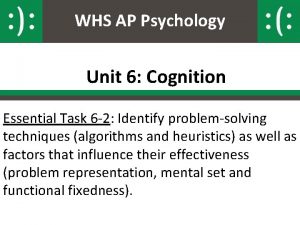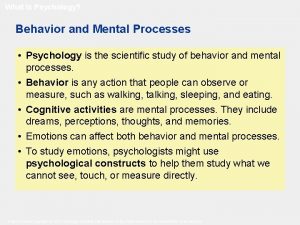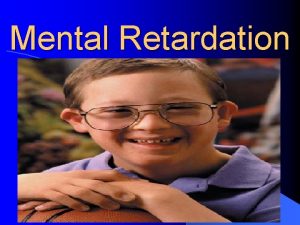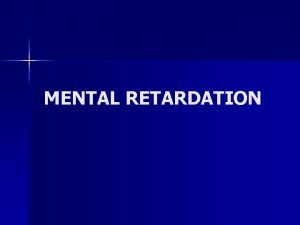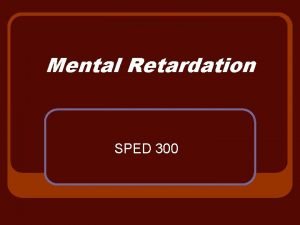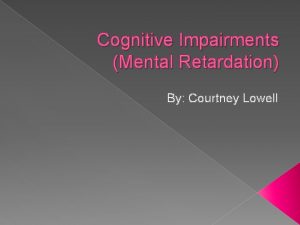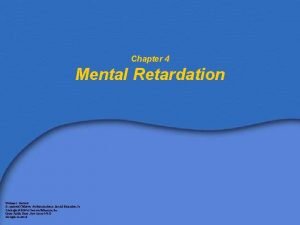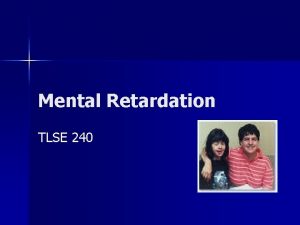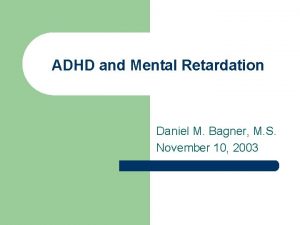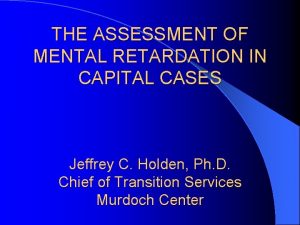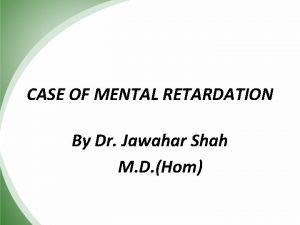MENTAL RETARDATION Definition Mental retardation MR is a










































- Slides: 42

MENTAL RETARDATION

Definition Mental retardation (MR) is a generalized disorder appearing before adulthood, characterized by significantly impaired cognitive functioning and deficits in two or more adaptive behaviors. n It has historically been defined as an Intelligence Quotient score under 70 n

Intelligence Quotient (IQ) n An intelligence quotient, or IQ, is a score derived from one of several different standardized tests designed to assess intelligence.

Grades of IQ 140 + Genius n 120 to 140 Very superior intelligence n 110 to 119 Superior intelligence n 90 to 109 Normal or average intelligence n 80 to 89 Dull n 70 to 79 Borderline deficiency n Under 70 Definite feeble mindedness n

Classification : It is classified as: 1 -Down`s syndrome. 2 -Phenylketonuria (PKU). 3 -Cretinism (Thyroid Deficiency). 4 -Cranial Anomalies. 5 -Microcephaly. 6 -Hydrocephalus. n

Down Syndrome n Down syndrome is a chromosomal condition characterized by the presence of an extra copy of genetic material on the 21 st chromosome, either in whole (trisomy 21) or part (such as due to translocations).

Down Syndrome (cont) n The incidence of Down syndrome is estimated at 1 per 733 births, although it is statistically more common with older parents due to increased mutagenic exposures upon some older parents' reproductive cells. Other factors may also play a role.

Down Syndrome (cont) n Often Down syndrome is associated with some impairment of cognitive ability and physical growth, and a particular set of facial characteristics. Individuals with Down syndrome tend to have a lower-than-average cognitive ability, often ranging from mild to moderate disabilities.

Down Syndrome (cont) n The average IQ of children with Down syndrome is around 50, compared to normal children with an IQ of 100. [5] A small number have a severe to high degree of intellectual disability.

Down Syndrome (cont)

Phenylketonuria (PKU) n Phenylketonuria is a rare metabolic disorder. In PKU the baby appears normal at birth but lacks an enzyme needed to break down phenylalanine, an amino acid found in protein foods. When this condition is undetected, the phenylalanine builds up in the blood and leads to brain damage.

Phenylketonuria (PKU)(cont) n The disorder usually becomes apparent between 6 and 12 months after birth, although such symptoms as vomiting, a peculiar odor, infantile eczema, (a skin disorder in infants), and seizures (fits) may become apparent during the early weeks of life.

Phenylketonuria (PKU)(cont) n Often the first symptoms noticed are signs of mental retardation, which may be moderate to severe, depending on the degree to which the disease has progressed. Motor incoordination and other neurological manifestations relating to the severity of brain damage are also common, and often the eyes, skin, and hair of untreated PKU patients are very pale.

Phenylketonuria (PKU)(cont) n PKU is thought to result from metabolic alterations involving recessive genes, and 1 person in 70 is thought to be a carrier.

Cretinism (Thyroid Deficiency) n Cretinism provides a dramatic illustration of mental retardation resulting from endocrine imbalance. In this condition, the thyroid either has failed to develop properly or has undergone degeneration or injury. In either case, the infant suffers from a deficiency in thyroid secretion. Brain damage resulting from this insufficiency is most marked during the prenatal and early postnatal periods of rapid growth.

Cretinism (Thyroid Deficiency) n Typical descriptions of cretins involve cases in which there has been a severe thyroid deficiency from an early age, often even before birth. Such a cretin has a dwarflike, thick-set body and short, stubby extremities. His height is usually just a little over 3 feet, the shortness accentuated by slightly bent legs and a curvature of the spine.

Cretinism (Thyroid Deficiency) n He walks with a shuffling gait that is easily recognizable. His head is large, with abundant black, wiry hair; his eyelids are thick, giving him a sleepy appearance; his skin is dry and thickened and cold on the touch. Other pronounced physical symptoms include a broad, flat nose, large and flappy ears, a protruding abdomen, and failure to mature sexually.

Cretinism (Thyroid Deficiency) n The cretins reveal a bland personality, and his thought processes tend to be sluggish. Most cretins fall within the moderate and severe categories of mental retardation, depending on the extent of brain damage. In cases with less pronounced physical signs of cretinism, the degree of mental retardation is usually less severe.

Cretinism (Thyroid Deficiency)

Cranial Anomalies n Mental retardation is associated with a number of conditions in which there are relatively gross alterations in head size and shape, and where the causal factors have not been definitely established. In macrocephaly ("large headedness"), for example there is an increase in the size and weight of the brain, an enlargement of the skull, and visual impairment, convulsions, and other neurological symptoms resulting from the supporting structure for brain tissue. Other cranial anomalies include microcephaly and hydrocephalus.

Microcephaly n The term microcephaly means "small headedness". It refers to a type of mental retardation resulting from impaired development of the brain and a consequent failure of the cranium to attain normal size. The most obvious characteristics of microcephalic is his small head, the circumference of which rarely exceeds 17 inches, as compared with normal of approximately 22 inches.

Microcephaly n Microcephalics differ considerably from each other in appearance, although there is a tendency for the skull to be coned shaped, with a receding chin and forehead. Microcephalics fall within the moderate, severe, and profound categories of mental retardation, but the majority shows little language development and is extremely limited in mental capacity.

Microcephaly

Hydrocephalus n Hydrocephalus is a relatively rare condition in which the accumulation of an abnormal amount of cerebrospinal fluid within the cranium causes damage to the brain tissues and enlargement of the cranium. In congenital cases of hydrocephalus, the head is either already enlarged at birth or begins to enlarge soon thereafter, presumably as a result of a disturbance in the formation, absorption, or circulation of the cerebrospinal fluid.

Hydrocephalus n The disorder can also develop in infancy or early childhood following the development of a brain tumor, subdural hemetoma, (clot in the brain covering), meningitis, (infection of brain covering) or other such conditions. Here the condition appears to result from a blockage of the cerebrospinal pathways and an accumulation of fluid in certain brain areas.

Hydrocephalus n The clinical picture of hydrocephalus depends on the extent of neural damage, which, in turn, depends on the age at onset and the duration and severity of disorder. In chronic cases the chief symptom is the gradual enlargement of the upper part of the head out of all proportion to the face and the rest of the body. While the expansion of the skull helps minimize destructive pressure on the brain, serious brain damage occurs nonetheless, leading to intellectual impairment and such other effects as convulsions and impairment or loss of sight and hearing.

Causes Of Mental Retardation: Prenatal n Natal n Postnatal n

Chromosomal disorders Downs syndrome, Fragile X syndrome, Klinefelters syndrome Single gene disorders Inborn errors of metabolism, such as galactosemia, phenylketonuria. Brain malformations such as genetic microcephaly, hydrocephalus Adverse material / environmental influences Deficiencies , such as iodine deficiency and folic acid deficiency Using substances such as alcohol Exposure to other harmful chemicals such as pollutants, heavy metals, harmful medications Infections e. g. TORCH HIV Prenatal

Natal Third trimester ( late pregnancy) Complications of pregnancy Diseases in mother such as heart and kidney disease and diabetes Placental dysfunction Labour (during delivery) Severe prematurity, very low birth weight, birth asphyxia Difficult and/or complicated delivery Birth trauma Neonatal (first four weeks of life) Septicemia, severe jaundice, hypoglycemia

Postnatal (in infancy and childhood) Brain infections such as tuberculosis, Japanese encephalitis, and bacterial meningitis Head injury Chronic lead exposure Severe and prolonged malnutrition Gross understimulation

Common features Delays in oral language development n Deficits in memory skills n Difficulty learning social rules n Difficulty with problem solving skills n Delays in the development of adaptive behaviors such as self-help or self-care skills. n

Diagnosis : n According to the latest edition of the Diagnostic and Statistical Manual of Mental Disorders (DSM-IV), three criteria must be met for a diagnosis of mental retardation:

n 1/ an IQ below 70 n 2/ significant limitations in two or more areas of adaptive behavior (as measured by an adaptive behavior rating scale, i. e. communication, self-help skills, interpersonal skills, and more) n 3/ evidence that the limitations became apparent before the age of 18.

Grades of MR : According to IQ : n Profound mental retardation Below 20 n Severe mental retardation 20– 34 n Moderate mental retardation 35– 49 n Mild mental retardation 50– 69 n Borderline intellectual functioning 70 -84 n

Management : n Management of mental retardation (MR) begins with breaking the news to parents of affected children sensitively, compassionately, and culturally appropriately

By most definitions mental retardation is more accurately considered a disability rather than a disease. n Currently, there is no "cure" for an established disability, though with appropriate support and teaching, most individuals can learn to do many things n

n The mainstay of treatment of MR is developing a comprehensive management plan for the condition. The complex habilitation plan for the individual requires input from care providers from multiple disciplines, including special educators, language therapists, behavioral therapists, occupational therapists, and community services that provide social support and respite care for families affected by MR.

Prevention : n Genetic: Prenatal screening for genetic defects and genetic counseling for families at risk for known inherited disorders can decrease the risk of inherited mental retardation.

n Social: Government nutrition programs are available to poor children in the first and most critical years of life. These programs can reduce retardation associated with malnutrition. Early intervention in situations involving abuse and poverty will also help.

n Toxic: Environmental programs to reduce exposure to lead, mercury, and other toxins will reduce toxinassociated retardation. However, the benefits may take years to become apparent. Increased public awareness of the risks of alcohol and drugs during pregnancy can help reduce the incidence of retardation

n Infectious: The prevention of congenital rubella syndrome is probably one of the best examples of a successful program to prevent one form of mental retardation. Constant vigilance, such as limiting exposure to cat litter that can cause toxoplasmosis during pregnancy, helps reduce retardation that results from this infection.

Thank you
 Nursing management of mental retardation
Nursing management of mental retardation Management of challenged children
Management of challenged children Mental retardation levels
Mental retardation levels Kode icd 10 takut ketinggian
Kode icd 10 takut ketinggian Chromosome 13 abnormality
Chromosome 13 abnormality Mental retardation classification
Mental retardation classification Nursing diagnosis mental retardation
Nursing diagnosis mental retardation Mental retardation levels
Mental retardation levels Causes of mental retardation
Causes of mental retardation What are the classification of mental retardation
What are the classification of mental retardation Retardation birefringence
Retardation birefringence What is this
What is this Psychomotor retardation
Psychomotor retardation Chapter 20 mental health and mental illness
Chapter 20 mental health and mental illness Mental health jeopardy game
Mental health jeopardy game Psychiatric nursing definition
Psychiatric nursing definition 4 types of mental preparation
4 types of mental preparation Mental modules definition
Mental modules definition Mental health definition
Mental health definition Mental disorder definition
Mental disorder definition Mental workload meaning
Mental workload meaning Abstract thought
Abstract thought Mental disorder definition
Mental disorder definition Objective about mental health
Objective about mental health Mental health definition
Mental health definition Mental effort meaning
Mental effort meaning Mental maths test year 5
Mental maths test year 5 Mental maths questions year 5
Mental maths questions year 5 Year 4 mental maths test
Year 4 mental maths test Year 4 mental maths tests
Year 4 mental maths tests Year 3 mental maths test
Year 3 mental maths test Year 1 mental maths test
Year 1 mental maths test Mentalset
Mentalset Study of behavior and mental processes
Study of behavior and mental processes What is a met call
What is a met call Lenawee county cmh
Lenawee county cmh Mental anatomical term
Mental anatomical term Desventajas del cálculo mental
Desventajas del cálculo mental Van buren community mental health
Van buren community mental health Vamos fazer atividade
Vamos fazer atividade Form a mental image of something; imagine
Form a mental image of something; imagine Examen mental enfermeria
Examen mental enfermeria Formal region
Formal region

